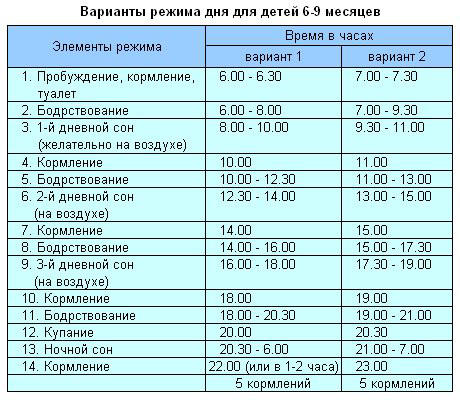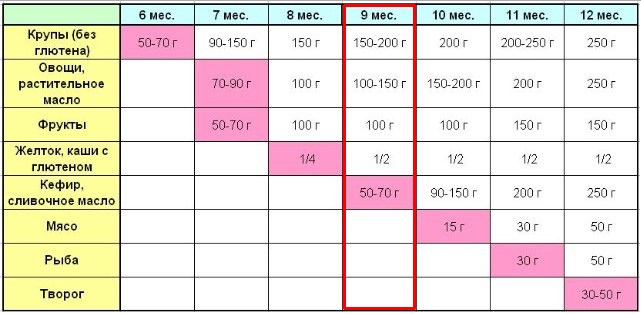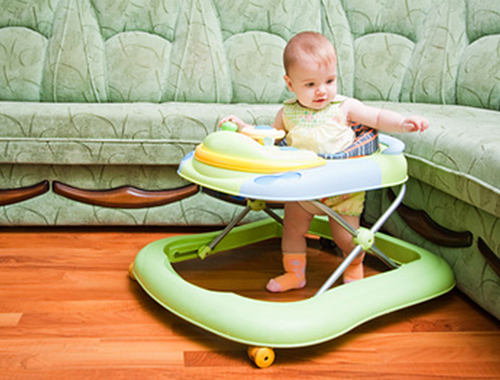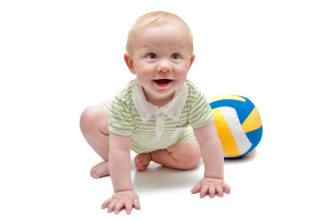The daily routine for a baby of 9 months is almost identical to that ofprevious month. Some changes can be seen only in the diet, the content of educational games and the renewal of the massage complex.

Approximate daily routine for a child of 9 months. Highlights
- 6:00-6:30 It's time to wake up and the first meal of the baby.
- 6:30-8:30 Morning period of wakefulness with mandatory implementation necessary hygiene procedures: washing, changing the diaper, taking air baths and light massage.
- 8:30-10:00 The first walk combined with a dream in the fresh air.
- 10:00-10:30 It's time for a second feeding.
- 10:30-14:00 The period of active knowledge of the world, including the implementation of charging and many developmental games.
- 14:00-14:30 The next feeding of crumbs.
- 14:30-16:00 Time to sleep. Sleep is not a walk.
- 16:00-18:00 The awakened baby is full of energy and is ready to perform physical exercises and cognitive games.
- 18:00-18:30 Time to eat.
- 18:30-20:30 A very good moment for a joint family walk, which all family members can go on.
- 20:30-22:00 It's time to communicate with households, favorable for calm games; evening baby bathing ritual.
- 22:00 Evening meal of the child.
- 22:30-6:00 Sleep until morning.
A few additional options with the daily routine (you will already find the best option considering the features of your crumbs):
The presented table is made taking into account the physiological needs of the child at 9 months: it has four-hour intervals between feedings, two walks are provided, and the intervals allotted for active leisure leave time for developing activities and performing physical exercises.
Sleep
The normal duration of sleep for a baby of this age is from eleven to fourteen hours during the day. The longest is the period of night rest.
Given the diversity of individual characteristics of nine-month-old babies, physiologists have found that most often their daytime sleep happens:
- Two-phase, consisting of two hour and a half periods. This is the best option for a day's rest, indicating the normal mental and emotional development of the baby.
- Three-phase, including two short-term forty-minute intervals of morning (at 9:00) and evening (at 19:00) rest and long daytime sleep lasting at least two hours. If this period coincides with the time of the walk, the baby can oversleep for three hours. Being a variant of the norm, such a schedule of sleep indicates excessive fatigue of the crumb, not yet ready for prolonged wakefulness.
Periods of daytime sleep are extremely important for the baby: they give him the opportunity to restore the spent energy and are a guarantee of his good mood.
About sleep disorders
 Parents often witness various violations of the normal sleep schedule:
Parents often witness various violations of the normal sleep schedule:
- Some crumbs may need rest not 2-3, but 4-5 times during the day, and the duration of their sleep is no more than half an hour.
- Other children sleep very badly at night: they constantly toss and turn, startle (why does a newborn baby startle in a dream?) often wake up crying (why do children cry in their sleep) and being capricious, and after waking up they cannot fall asleep for a very long time. Having calmed down in Mom’s hands after much persuasion and motion sickness, they are briefly forgotten by an alarming shallow sleep in order to soon wake up again.
In order to normalize the baby’s sleep, it is necessary to find and eliminate the cause that provoked a violation of its quality and cyclicity.
The culprit in the disturbance of daytime sleep is most often the baby’s overwork due to the abundance of external stimuli: a large number of people in the house, intrusive games of older children, too loud music, as well as too high temperature and dry air in the children's room (about optimal temperature).
To normalize night rest, the following conditions must be met:
- Before laying the baby, the children's room should be well ventilated. Sleep with a slightly open window guaranteeing a constant flow of fresh air is an ideal option to maintain a comfortable microclimate;
- If the sleeping baby has the habit of dropping a blanket, there is no need to stand over his bed all night. It is enough just to properly wear it before bedtime. In addition to a disposable diaper, the baby should have light pajamas and socks;
- Excellent options for preparatory procedures that contribute to a long night's rest are: performing gymnastics associated with a relaxing massage and a ritual of evening bathing for the baby;
- Games preceding falling asleep should be calm;
- It is very good if parents include the tradition of reading good tales in the procedure for laying the child. The grown-up baby is already able to listen to 2-3 not too long text;
- An excellent sound background for falling asleep is a quiet lullaby.
Parents are often disturbed by the restless night's sleep of the child. The complaints are different: the baby falls asleep badly, often wakes up, cries in a dream. Why is this happening and what needs to be done?
About Diet
Knowing that the diet of a 9-month-old child includes five feedings, and the daily amount of food eaten (not including drinking) should be at least one liter, it is easy to calculate that for one feeding he should receive at least 200 ml of products intended for baby food .
Starting from this age, in many mothers, breastfeeding begins to fade into the background (the baby is given breasts upon awakening and when laid down at night). The basis of the children's diet from now on is made up of soups, cereals, vegetable and fruit purees. To increase the nutritional value of the dish, it is advisable to add meat, cut into small pieces, in light soups and vegetable purees. Since the baby by this time has several (from 4 to 6) teeth, the need for rubbing disappears.
Boiled egg yolk is no less nutritious, it is also added to soups and mashed potatoes, thereby adding variety to the children's menu. You should only remember that you should not give crumbs meat and yolk on the same day.
At this age, you can introduce your child to dishes from low-fat varieties of ocean fish (cod, pollock, haddock, hake, flounder). Given the high allergenicity of this product, it should be administered gradually and very carefully.starting with half a teaspoon of steamed or boiled fish fillet (you can also give mashed fish from a jar).
If you feed the baby in the morning, you can observe the reaction of his body. However, no other new products should be given to him. If, after meeting with a new dish, his cheeks did not turn red and a rash did not appear, this indicates that he does not have an allergic reaction to the fish. So, next time the portion of fish can be slightly increased.
It is very important that the diet of the growing crumbs should have enough fresh vegetables and fruits: saturating his body with vitamins and minerals, in some cases they can solve problems with the normalization of stool. When constipation occurs, peach or plum puree can play the role of a safe natural laxative. Slices of fruits (peaches, bananas, apples) and berries can be added to cereals and children's cottage cheese: this will improve their taste and increase their nutritional value.
It will be useful for young mothers to look at an approximate daily diet plan for grown-up crumbs:
- 6:00 The awakened baby is applied to the chest, and the artificial person is given a bottle with the milk mixture.
- 10:00 An excellent breakfast option is porridge and mashed fresh fruit.
- 14:00 For lunch, you can offer your baby a vegetable soup with pieces of meat or egg yolk. A good option for a meal can be a vegetable puree with meat, and a grated apple is suitable as a dessert. A complete substitute for meat over time can be dishes from ocean fish.
- 18:00 The best time for a snack of baby curd and fruit juice. The crumbs who love more nutritious food can have dinner with a porridge with pieces of finely chopped meat.
- 22:00 The falling asleep baby is again applied to the mother's breast or the milk mixture is given.
To maintain the correct water balance in the baby’s body, the mother should make sure that he receives the necessary amount of liquid: baby tea, drinking water, fruit drinks and juices.
Heading – feeding a baby
My feeding table at 6-9 months
About physical development
Nine-month-old kids get on their feet and start to walk supported by both handles or holding onto any support. In order to help strengthen their muscles, you need to do gymnastics at least twice a dayincluding in the complex exercises:
- with circular rotation of the handles;
- for flexion and extension of the legs (simultaneous and alternating);
- with alternating flexion and extension of the arms of the baby holding on to his mother’s fingers;
- stimulating crawl;
- with the implementation of sliding steps;
- squats (supported by armpits);
- with the body tilted forward (with straightened legs).
READ ALSO: teach your baby to walk - 10 ways
Before performing the next exercise, it is necessary to relieve tension from the muscles with a light relaxing massage. Each movement should be repeated at least five times, and the total duration of the complex should not exceed ten to fifteen minutes.
In an effort to teach the baby to walk as quickly as possible, many mothers use walkers, unaware that this simple simulator is too heavy a load for unstable legs.
Even an experienced pediatrician can’t say exactly what kind of load is necessary for the proper development of a child, and for some mothers who are carried away by household chores, babies are in the walker for an unreasonably long time. That is why it is better to refuse the use of walkers, giving the baby the opportunity to independently learn new skills.
READ ALSO: walkers PRO and CON
About educational games and activities
- Favorite games of the kids are still “Ladushki”, “Magpie-Crow”;
- Nine-month age is the time of active development of fine motor skills, which is why babies begin to show interest in small objects, trying to pick a flower or pick up a pebble during a walk. Knowing this, the mother should control her baby, stopping all his attempts to send the find in her mouth. But during feeding, this interest should be fully supported, giving the baby the opportunity to hold slices of bread or slices of fruit in their hands. It is also useful to give him a spoon - time after time trying to manage it, the baby will learn to eat independently after some time (10 ways to teach your baby to eat with a spoon);
- The development of fine motor skills is greatly facilitated by activities consisting in the insertion (and subsequent extraction) of peas, beans or lentils in a lump of salt dough. You can offer the crumbs to collect in a box crumbled buttons, large beads or pebbles. During these classes, an adult should very carefully observe the baby pulling each item in his mouth;
- Kids of this age really like the game of hide and seek. Both parents can take part in the game. One, hiding around the corner, should say "cuckoo" and for an instant seem crumbs. After that, taking the baby in her arms, the mother can hide with him and peek around the corner in the same way. There will be no limit to the delight of the crumbs;
- It is time to introduce the child to the idea of color. For several days, you can lay out with it a turret of one-color cubes, all the while focusing his attention on the name of their color. Then you can add one cube of contrasting color. Let the baby remember and recognize the difference in colors. After some time, you can ask him to submit a cube of a certain color. A variant of the game is to work with the sizes (large-small) and the number (one-many) of objects (we teach colors with a child - 5 techniques).
READ ALSO: baby development at 9 months and read about baby skills at 9 months
Following the same daily regimen daily disciplines the baby, forms a number of useful skills and habits (for example, the morning wash, the desire to wash hands before eating, the habit of waking up and eating by the hour, the ritual of taking a bath every night), which will be useful to him in further.
← daily regimen of 8 months daily routine of 10 months →
VIDEO GUIDE
***












It seems to me that the authors of the article did not take into account the fact that each child is individual. Many might think that a child should be awakened at 6 in the morning, even if he is sleeping. My baby, for example, as it is not strange, can oversleep until 9-10 in the morning. I do not think it is right to wake her earlier.
In the text about food, one thing, and in the table - another. In the text, both meat and fish are already given, but this is not in the table, and even cottage cheese is already at 12 months old. Authors, you contradict yourself! Also: you do not need to grind the food, because the child has 4-6 teeth ?! Have you seen children alive? I have never met teeth in nine-month-old 6 teeth. My daughter has two. Therefore, I continue to make mashed potatoes in a blender.
Plus about the rises at 6 in the morning. And if my child sleeps from 10 pm to 10 am with breaks at night, what is the schedule? I won’t wake her up)))
My child has 6 teeth at 8 months and at 9 climbs 7th?
We also have 7 teeth, we are 8.5
You can stick to this mode if you have a housekeeper, and when to do household chores !! ??
Absolutely thoughtless article !!! Our child at 6 in the morning no longer eats, for example. Eats 4 times a day. And if you live in such a regime, then you won’t do anything !!
My daughter is 8 months old and we have 8 teeth. And the next climb. The article is not very ((((